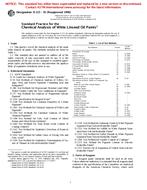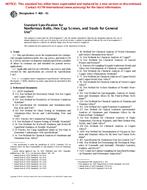1.1 The use of small environmental test chambers to develop emission characteristics of indoor materials and products is still evolving. Modifications and variations in equipment, testing procedures, and data analysis are made as the work in the area progresses. Until the interested parties agree upon standard testing protocols, differences in approach will occur. This guide will provide assistance by describing equipment and techniques suitable for determining organic emissions from indoor materials. Specific examples are provided to illustrate existing approaches; these examples are not intended to inhibit alternative approaches or techniques that will produce equivalent or superior results.
1.2 Small chambers have obvious limitations. Normally, only samples of larger materials (for example, carpet) are tested. Small chambers are not applicable for testing complete assemblages (for example, furniture). Small chambers are also inappropriate for testing combustion devices (for example, kerosene heaters) or activities (for example, use of aerosol spray products). For some products, small chamber testing may provide only a portion of the emission profile of interest. For example, the rate of emissions from the application of high solvent materials (for example, paints and waxes) via brushing, spraying, rolling, etc. are generally higher than the rate during the drying process. Small chamber testing can not be used to evaluate the application phase of the coating process.
1.3 The guide does not provide specific guidance for determining emissions of formaldehyde from pressed wood products, since large chamber testing methods for such emissions are well developed and widely used. It is possible, however, that the guide could be used to support alternative testing methods.
1.4 While the ultimate purpose of any evaluation of indoor materials is to determine whether the emissions can contribute to health or comfort problems, this guide is only applicable to the determination of the emissions themselves. The effect of the emissions (for example, toxicity) is beyond the scope of the guide.
1.5 As an ASTM guide, options are described, but specific courses of action are not recommended. The purpose of this guide is to increase the awareness of the user to available techniques for evaluating organic emissions from indoor materials/products via small chamber testing and to provide information from which subsequent evaluation and standardization can be derived.
1.6 Within the context of the limitations discussed in this section, the purpose of this guide is to describe the methods and procedures for determining organic emission rates from indoor materials/products using small environmental test chambers. The techniques described are useful for both routine product testing by manufacturers and testing laboratories and for more rigorous evaluation by indoor air quality (IAQ) researchers. Appendix
1.7 The values stated in SI units are to be regarded as standard.
1.8 This standard does not purport to address the safety problems associated with its use. It is the responsibility of the user of this standard to establish appropriate safety and health practices and determine the applicability of regulatory limitations prior to use.
Product Details
- Published:
- 12/10/1997
- Number of Pages:
- 15
- File Size:
- 1 file , 180 KB


